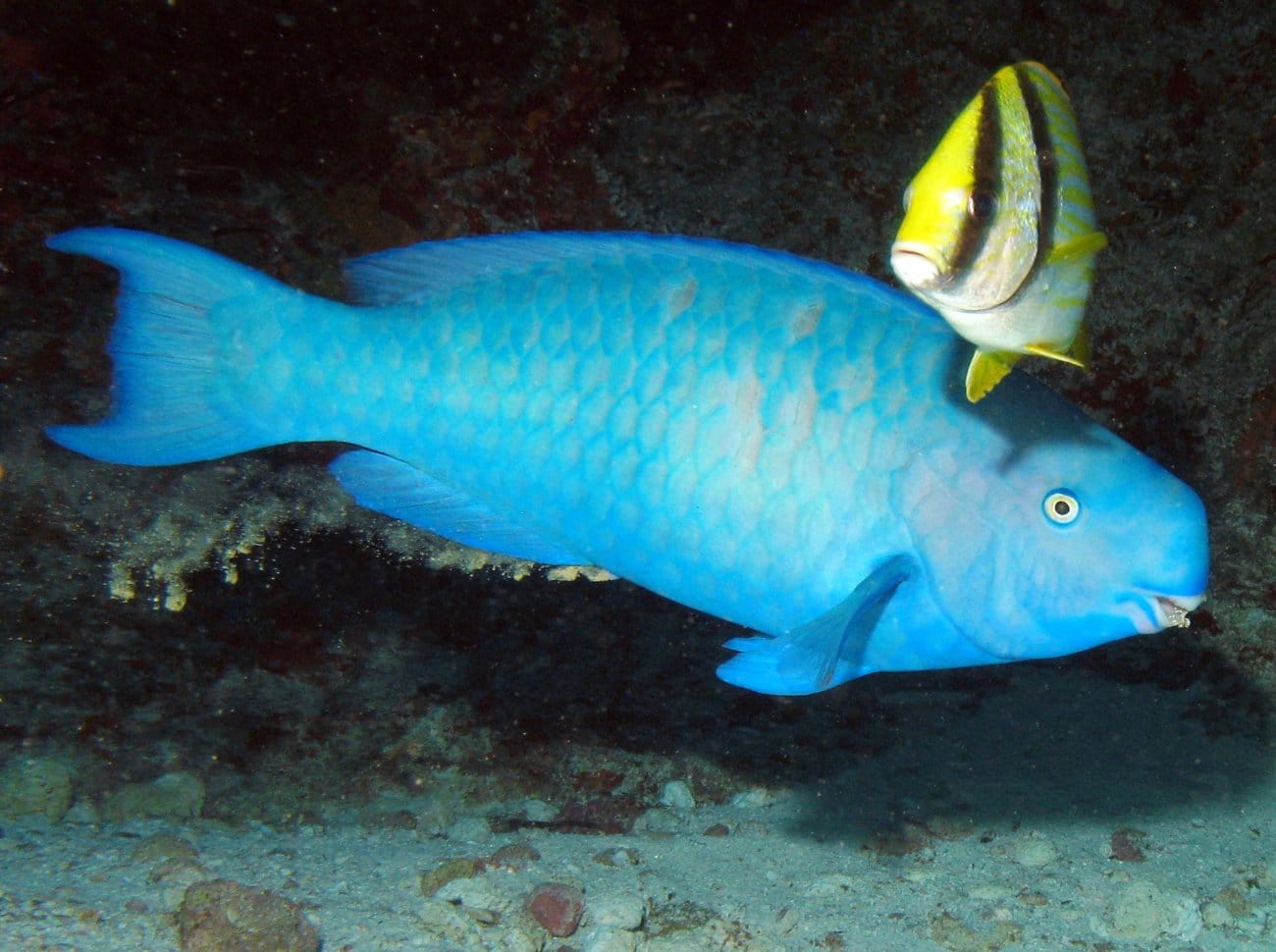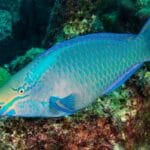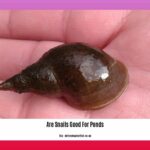Dive into the captivating world of the dazzling Blue Parrotfish! These electric blue wonders play a critical role in maintaining the health of coral reefs. With their unique beak-like mouths, they graze on algae, keeping the reefs vibrant. Let’s explore their fascinating lives, from their feeding habits and social interactions to their remarkable transformation and the crucial role they play in shaping the underwater world.
The Blue Parrotfish: A Coral Reef Guardian
The vibrant blue of the Scarus coeruleus, commonly known as the Blue Parrotfish, is a frequent sight in thriving coral reefs. This striking fish, with its distinctive beak-like mouth, is a vital component of the reef’s ecosystem. It acts like a diligent gardener, constantly pruning and maintaining the coral gardens.
The Parrotfish’s Role in Algae Control
The Blue Parrotfish is primarily an herbivore, its diet mainly consisting of algae. This algae can smother coral colonies if left unchecked. By consistently grazing on this algae, the parrotfish acts as a natural cleaning crew, ensuring the coral receives the sunlight it needs to flourish. This makes the Blue Parrotfish crucial for the coral reef ecosystem, a tiny landscaper maintaining the reef’s delicate balance.
The Parrotfish’s Colorful Transformation
The vibrant blue we associate with the adult Blue Parrotfish isn’t present throughout its life. Juvenile parrotfish display a mix of muted blues and yellows, even sporting a distinctive yellow spot on their heads. As they mature, this slowly transitions to the iconic solid blue. This dramatic change probably relates to shifts in their roles within the reef community as they mature, though further research is needed to fully understand this fascinating transformation.
Conservation Concerns for the Blue Parrotfish
Despite its relatively wide distribution, the Blue Parrotfish faces growing threats. Coral reef degradation, primarily due to climate change and pollution, shrinks its habitat. Overfishing also presents a significant danger, as parrotfish can become bycatch or are directly targeted for food. Implementing sustainable fishing practices and protecting coral reef habitats are crucial for the survival of these brilliant creatures.
The Parrotfish’s Remarkable Beak
One of the Blue Parrotfish’s most striking features is its beak-like mouth, formed by fused teeth. This powerful tool is perfectly adapted for scraping algae off coral, showcasing a marvel of evolution. Some scientists even suggest that the crunching action of the parrotfish’s beak contributes to the sandy beaches we enjoy—they grind up the ingested coral and algae, excreting it as sand.
Ongoing Research and the Uncertain Future
While our understanding of the Blue Parrotfish has grown, many questions remain. Researchers continue to study their complex interactions within the reef, their role in nutrient cycling, and the effects of changing ocean conditions. They also investigate the specific types of algae they prefer and how these preferences may influence the overall health and diversity of the coral reef. This ongoing research is essential for developing effective conservation strategies.
Are Blue Parrotfish Rare?
Given their vibrant presence on coral reefs, it’s natural to wonder about the rarity of blue parrotfish (Scarus coeruleus). The good news is that they are not currently considered rare globally. The International Union for Conservation of Nature (IUCN) lists them as a species of “Least Concern,” suggesting their populations are relatively stable worldwide. However, “stable” doesn’t mean unchanging. Populations naturally fluctuate due to factors like food availability, predator-prey dynamics, and environmental shifts. Ongoing research continuously refines our understanding of their population status.
Blue parrotfish are essential to coral reef health, grazing on algae to prevent overgrowth that could smother the coral. This grazing also produces sand, contributing to the beautiful white beaches we enjoy.
Despite their overall stable status, blue parrotfish face challenges. Habitat destruction, particularly coral bleaching due to rising ocean temperatures, threatens their homes and food sources. Fishing also pressures local populations, though the impact varies depending on location and fishing methods. Marine protected areas (MPAs) play a vital role in offering refuge, likely contributing to the stability of blue parrotfish populations. Ciguatera fish poisoning, sometimes associated with consuming reef fish including parrotfish, is another concern requiring further research.
Protecting their coral reef habitats, managing fisheries sustainably, and researching issues like ciguatera are essential for ensuring these fish continue to thrive. Their well-being is intrinsically linked to the health of coral reefs, vital for biodiversity, coastal protection, and tourism. If you are curious to know about the nocturnal gecko that can hide perfectly in any environment, then you must click on this link about the satanic leaf tailed gecko.
Why Are Blue Parrotfish Blue?
The blue parrotfish’s vibrant, electric blue color is a defining feature. This striking coloration isn’t present throughout their lives; it’s a transformation. Juvenile blue parrotfish have a gold spot on their heads, which fades as they mature, giving way to a purplish hue before finally transforming into the intense blue of adulthood. This dramatic change is unique to Scarus coeruleus, aptly meaning “blue fish.”
This vibrant blue likely serves multiple purposes. It may act as camouflage in the open ocean, blend in with the deep water and offer protection from predators. It could also play a role in communication within the species, perhaps for attracting mates or establishing dominance. The parrotfish’s algae-rich diet may also influence their color. Ongoing research explores the interplay of genetics, environment, and diet in this remarkable transformation.
We all know the symbol of scarab beetles in ancient Egypt. If you want to know what the scarab beetle symbolizes, you can click on this link about the scarab beetle meaning.
Do Blue Parrotfish Have Teeth?
The Blue Parrotfish’s “teeth” are a fascinating adaptation. Their beak-like jaw is formed by fused teeth, acting as a scraper for grazing on algae and small organisms on coral and rocks. However, their true teeth are pharyngeal teeth located in their throat. These robust teeth grind the ingested coral into fine sand, distinguishing them from most other fish. This constant grazing benefits the coral reef by controlling algae growth, creating a symbiotic relationship.
This grinding process produces significant amounts of sand, contributing to beach formation and even small islands, showcasing the parrotfish’s role as geological engineers. While not currently endangered, they are vulnerable to pollution, overfishing, and the effects of climate change, particularly coral bleaching. Ongoing research focuses on their behavior, diet, and interactions with the environment, seeking to understand their intricate role in maintaining healthy coral ecosystems. Protecting them safeguards the entire intricate ecosystem they support.
- Unlock Filipino Culture: A Deep Dive into Traditions and Practices - April 23, 2025
- Unlock Spanish Culture: Insights & Opportunities Now - April 23, 2025
- White Spirit Uses & Substitutes: A Deep Dive for Pros & DIYers - April 23, 2025

















1 thought on “The Brilliant Blue Parrotfish (Scarus coeruleus): A Deep Dive into Its Life and Importance to Coral Reefs”
Comments are closed.